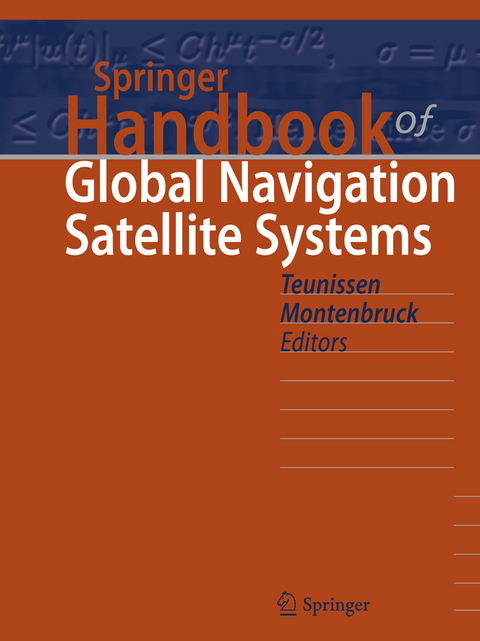
Springer Handbook of Global Navigation Satellite Systems
Springer International Publishing (Verlag)
978-3-319-42926-7 (ISBN)
- Titel ist leider vergriffen;
keine Neuauflage - Artikel merken
Peter Teunissen is a Professor of Geodesy and Satellite Navigation at Curtin University, Australia, and Delft University of Technology (TU Delft), the Netherlands. His research is focused on developing theory, models and algorithms for high-accuracy geospatial applications of new global and regional satellite navigation systems. His pioneering contributions to the field include statistical and numerical methods of integer inference theory, innovative algorithms for multi-GNSS precise parameter estimation, and the early characterization and utilization of the Chinese BeiDou, the Indian IRNSS and the Russian GLONASS CDMA system. His scientific contributions have been recognized through various awards including the Bomford Prize, the Steven Hoogendijk Prize and the Alexander von Humboldt Award. He holds an Honorary Degree from the Chinese Academy of Sciences and is a Fellow of the International Association of Geodesy (IAG), the UK Royal Institute of Navigation (RIN), the US Institute of Navigation (ION) and the Royal Netherlands Academy of Sciences (KNAW). Oliver Montenbruck is Head of the GNSS Technology and Navigation Group at the DLR’s German Space Operations Center, Oberpfaffenhofen and Chair of the Multi-GNSS Working Group of the International GNSS Service. His research activities comprise space borne GNSS receiver technology, autonomous navigation systems, spacecraft formation flying and precise orbit determination. More recently, he has focused on the characterization of new satellite navigation systems and multi-GNSS processing. Pioneering contributions in this field included GIOVE and GPS signal investigations based on high-gain antenna measurements, the establishment of the Cooperative Network for GNSS Observation (CONGO), and the evaluation of triple-frequency signals, as well as the early characterization and utilization of the Chinese BeiDou navigation system. His scientific contributions have been recognized through various awards including the DLR Senior Scientist Award, the Institute of Navigation’s (ION) Tycho Brahe Award, and the GPS World Leadership Award.
Part A: Fundamentals of GNSS. .- Introduction to GNSS.- Time and Reference Systems.- Satellite Orbits and Attitude.- Signals and Modulation.- Clocks.- Atmospheric Signal Propagation.- Part B: Satellite Navigation Systems: .- The Global Positioning System (GPS).- GLONASS.- Galileo.- Chinese Navigation Satellite Systems.- Regional Systems.- Space Based Augmentation Systems.- Part C: GNSS Receivers and Architecture: .- Receiver Architecture.- Signal Processing.- Multipath.- Interference.- Antennas.- Simulators and Test Equipment.- Part D: GNSS Algorithms and Models: .- The Basic Observation Equations.- Combinations of Observations.- Positioning Model.- Least-Squares Estimation and Kalman Filtering.- Carrier Phase Integer Ambiguity Resolution.- Batch and Recursive Model Validation.- Part E: Positioning and Navigation: .- Precise Point Positioning.- Differential Positioning.- Attitude Determiantion.- GNSS/INS Integration.- Land and Marine Applications.- Aviation Applications.- Ground Based Augmentation Systems.- Space Applications.- The International GNSS Service.- Part F: Surveying, Geodesy and Geodynamics: .- Orbit and Clock Product Generation.- Surveying.- Geodesy.- Geodynamics.- Part G: GNSS Remote Sensing and Timing: .- Monitoring of the Neutral Atmosphere.- Ionospheric Monitoring.- Reflectometry.- GNSS Time and Frequency Transfer.- Appenidx: .- Data Formats.- GNSS Parameters.
| Erscheinungsdatum | 30.05.2017 |
|---|---|
| Reihe/Serie | Springer Handbooks |
| Zusatzinfo | XX, 1272 p. 818 illus. in color. |
| Verlagsort | Cham |
| Sprache | englisch |
| Maße | 193 x 260 mm |
| Themenwelt | Naturwissenschaften ► Geowissenschaften ► Geografie / Kartografie |
| Schlagworte | Aerospace Technology and Astronautics • Earth and Environmental Science • Galileo • Geographical Information Systems/Cartography • Geophysics/Geodesy • Global Navigation Satellite Systems • Global Positioning System • GLONASS • GNSS • GNSS Agorithms • GPS • navigation and positioning • Precise Point Positioning • Remote Sensing • Signal, Image and Speech Processing • Special purpose and application-based systems • Transportation |
| ISBN-10 | 3-319-42926-4 / 3319429264 |
| ISBN-13 | 978-3-319-42926-7 / 9783319429267 |
| Zustand | Neuware |
| Haben Sie eine Frage zum Produkt? |
aus dem Bereich


